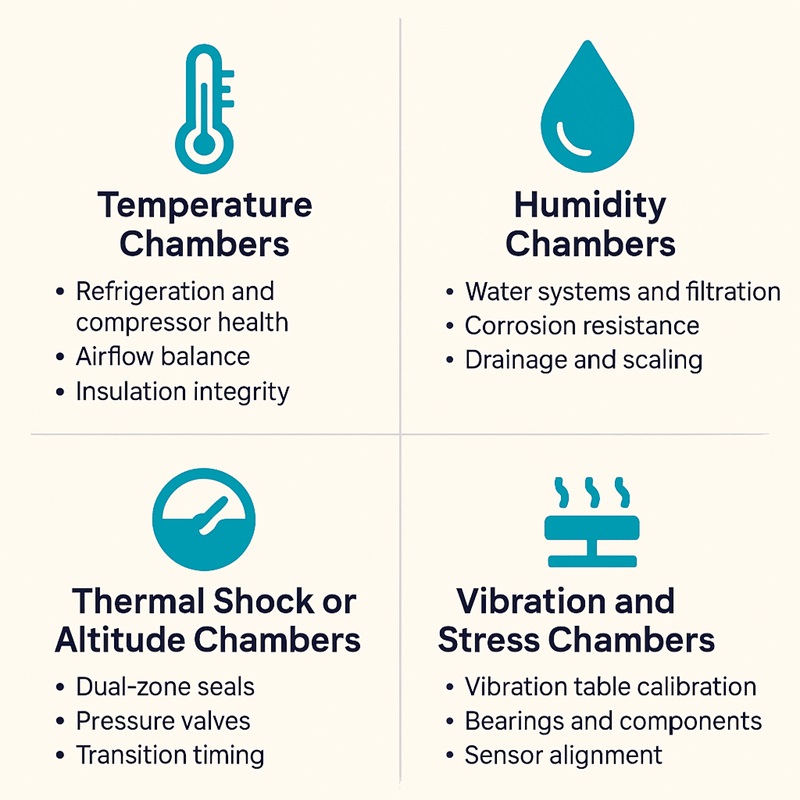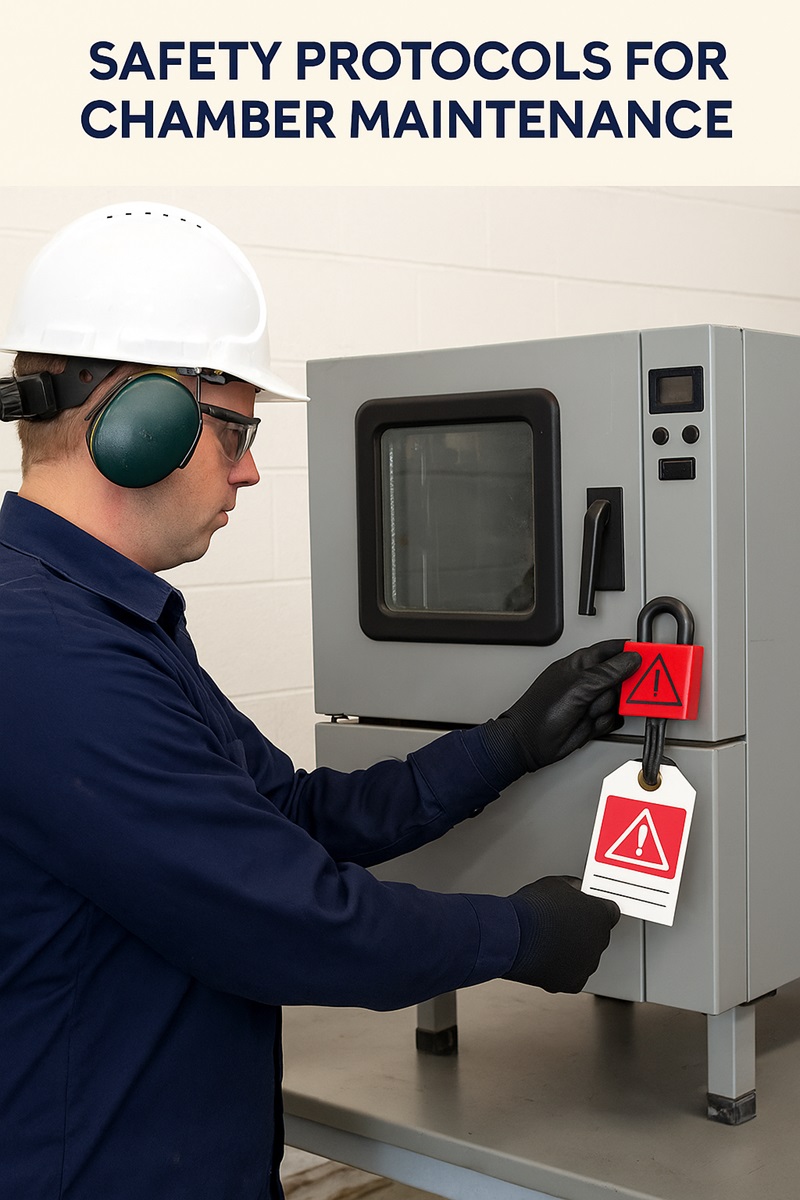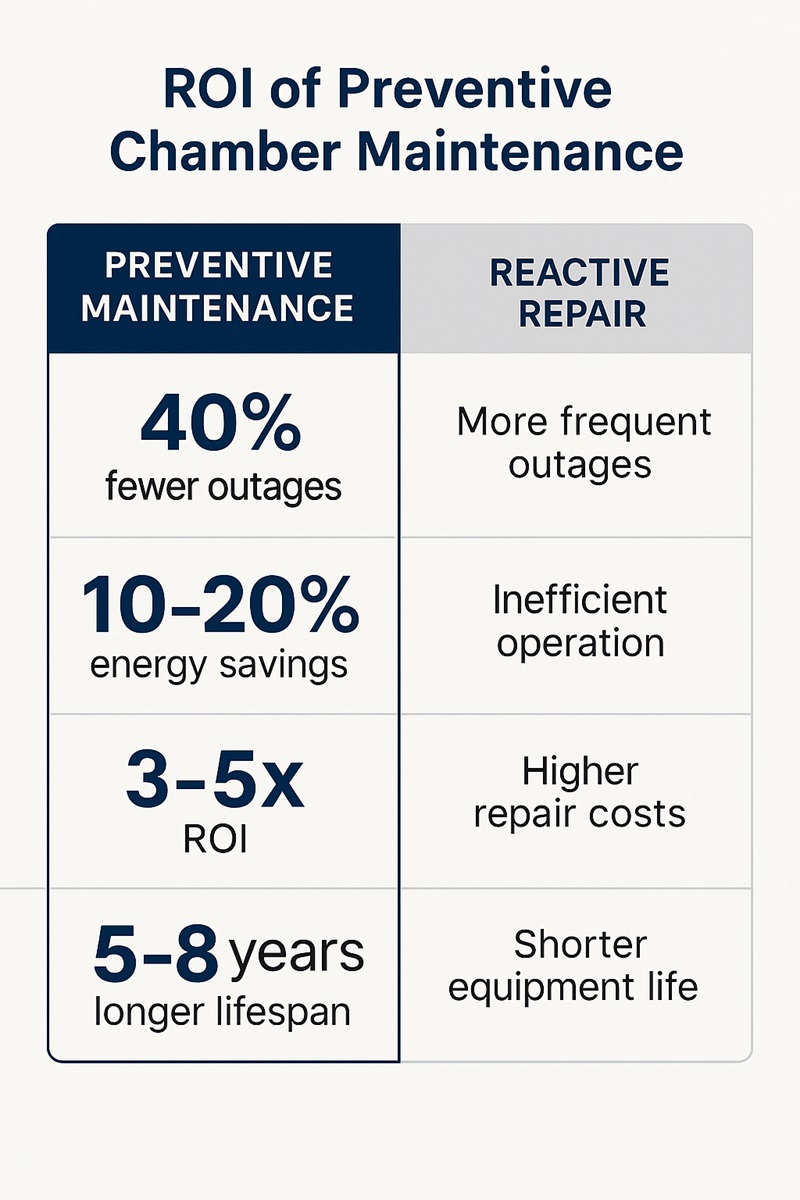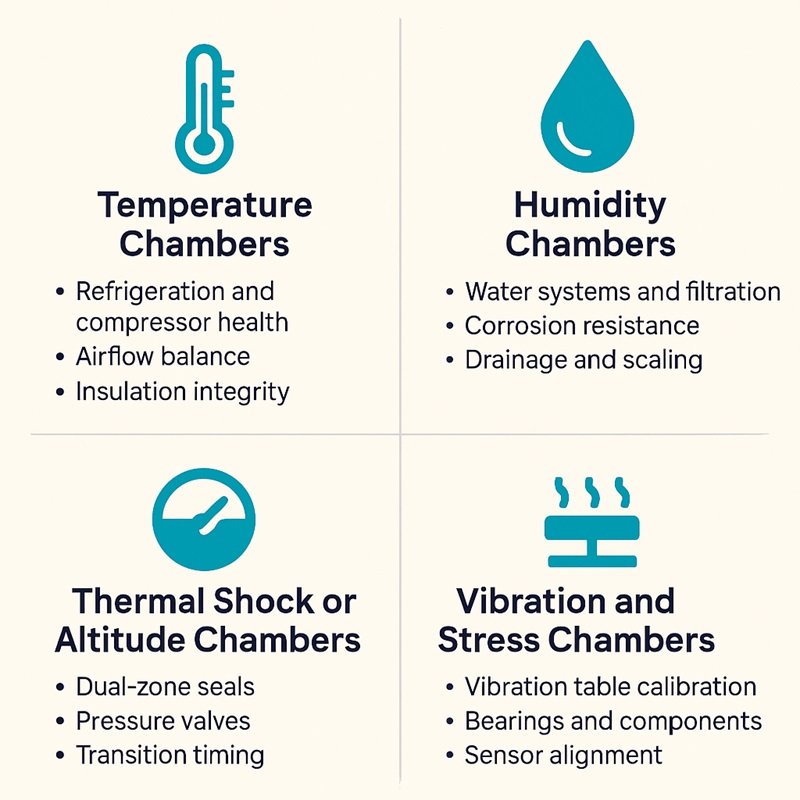What Is an Environmental Chamber?
An environmental chamber, also called a test chamber, is a special box that controls heat, cold, and moisture. It helps scientists see how products react under different conditions.
These chambers can create high heat, freezing cold, or high humidity to test how materials or parts hold up.
Industries like electronics, cars, airplanes, and medicine use them to make sure products are safe, strong, and ready for real-world use.
In general, since an environmental test chamber may start showing signs of strain through erratic temperature swings, humidity drifts, or peculiar noise, knowing how to act towards such conditions cuts times and costs considerably. This guide provides actionable steps and insights taken from the data of the industry and seasoned practice so that you can extend the life and performance of your equipment rather than merely react when things go wrong.
Understanding Why Chambers Demand Solid Maintenance
The global market for environmental test chambers was estimated to be approximately USD 946.6 million in 2022 and is expected to grow at a compound annual rate of about 3% through 2030.The growth indicates that more laboratories, manufacturers, and R&D facilities depend on chambers for crucial testing. As the intensity of usage grows, structured maintenance becomes less optional and more a question of necessity.
Failures often come from predictable sources: worn out door-seals, compromised insulation, failing sensors or miscalibrated control systems. According to one practitioner, “If you neglect maintenance, not only do test results become unreliable, but component failures and unplanned downtime follow.”

Types of Environmental Chambers and Their Care
Not all chambers work the same way. Each has its own parts and care needs.
Temperature Chambers
Keep the compressor in good shape. Make sure air moves freely and insulation stays tight.
Humidity Chambers
Check water filters often. Clear out drains and stop rust before it starts.
Thermal-Shock or Altitude Chambers
Watch the seals, pressure valves, and how fast the chamber switches zones.
Vibration Chambers
Look at the vibration table, bearings, and sensors for any signs of wear.
Giving each chamber the right kind of care helps it last longer and stay accurate.
Step 1: Establish a Baseline Inspection Schedule
Start off by cataloging the components of the chamber and their anticipated behavior. Do not rely solely on your memory—record the readings such as setpoints, ramp rates, humidity control, and sensor drift. Study the manufacturer’s manual, paying particular attention to:
Temperature and humidity uniformity and control.
Sensor calibration and drift over time.
Mechanical integrity of refrigeration and air-flow systems
Structural elements such as seals, doors, and insulation.
As one technical service provider wrote: “Test chambers are subject to changes if insulation is poor and sensors are faulty.”
Step 2: Quarterly and Annual Maintenance Tasks
Here’s a schedule that aligns with industry best practice:
Quarterly Tasks:
Measure compressor and refrigeration system pressures; clean condenser coils.
Check filters on humidity systems, piping and water trays for blockages or corrosion.
Inspect the electrical systems—test switches, verify amp draws.
Clean door seals, gaskets, hinges and air registers.
Annual Tasks:
Calibrate sensors and controllers; check ramp-rate performance.
Assess wear and lubrication points of mechanical systems.
Internal cleaning of the control panel: air blow-out, verify wiring and ground connections.
Review firmware/software updates in systems with digital control and IoT-connectivity.
Step 3: Receive warning signs before they escalate.
This can save you from some major repair bills by monitoring usage and keeping a log of anomalies. Here are indications that something needs attention:
Temperature or humidity does not attain target level or does so too slowly.
Unexpected cycling of compressor or heater.
Unusual condensation or pooling inside or around the chamber.
Controls that give more frequent alarms or fail to respond.
Catch any of these and act quickly. The sooner a problem is diagnosed, the simpler the fix, not a complete overhaul.
Step 4: Repair vs. Replace – Choosing Smartly
When you do bring in professional service, ask the right questions:
Is the problem specific (sensor drift, leaky seal) or systemic in origin-insulation failure, compressor wear?
Can parts be sourced easily? Often chambers remain in service for a very long time after their original vendor supports them—yet repairs, as one industry blog notes, require “manufacturer-trained technicians because specialized parts and expertise are needed.”
What is the risk for downtime? A top-tier service provider explains that even short disruptions may derail product timelines and cost more than the repair itself.
That’s where a standout, technician-driven company comes in. Take for instance Environmental Chamber Repair Service Provider, which provides strategies to mitigate: multi-vendor part sourcing, hybrid preventive/monitoring support, and fast-response availability to keep labs moving and test results intact.
Common Issues and Quick Fixes
| Symptom | Likely Cause | Recommended Action |
| Temperature takes too long to stabilize | Clogged vents or refrigerant loss | Clean vents; inspect lines |
| Excess condensation inside chamber | Humidity probe or drainage fault | Replace probe; clear drains |
| Compressor shuts down suddenly | Overload relay or power fluctuation | Check relay and voltage |
| Sensor drift | Mis-calibration or aging probe | Recalibrate or replace sensor |
| Excessive noise/vibration | Fan imbalance or bearing wear | Rebalance or lubricate |
Step 5: Include Preventive Monitoring and Service Plans
Don’t wait for a failure. Establish a plan to prevent it:
Scheduled inspection calls, remote sensor reporting, trend-analysis of control logs.
Defined service windows and minimum response times.
Spare parts inventory strategy: Stock spares for easily worn items, such as door seals, filters, and sensors.
Record all the following: service history, performance drift, and calibration results.
This approach builds operational continuity and controls cost instead of allowing surprises to drive budget. One such blog attests, “A properly maintained test chamber can remain operational for 15 years or more.”

Safety and Handling Precautions
Safety is essential during chamber maintenance:
- Lock-out/Tag-out: Isolate power before servicing.
- PPE: Gloves, safety goggles, and anti-slip footwear.
- Refrigerant Handling: Follow EPA 608 recovery standards.
- Heat Safety: Allow full cooldown on high-temp units.
Proper procedures protect staff, data, and compliance status.
Step 6: Ensure Regulatory Compliance & Data Integrity
Environmental chambers play a very important role in many industries, such as automotive, electronics, aerospace, and pharmaceuticals, in the generation of data for various tests that need to conform to set standards such as MIL-STD-810, ISO, or ASTM.
If your chamber drifts out of spec, the integrity of your results and the risk of non-compliance rise. By maintaining calibration and repair logs, you preserve audit trails and keep test outcomes valid.

Cost-Benefit and Downtime Prevention
Taking care of an environmental test chamber is more than fixing it when it breaks. It’s a smart business move that saves money, time, and energy over the long run. Regular care costs less than surprise repairs and keeps the system running smoothly.
Less Downtime, More Work Done
Unexpected breakdowns can stop testing, delay projects, and even affect compliance.
Studies show that labs with planned maintenance have up to 40% fewer shutdowns than those that only fix problems when they happen.
Each lost test hour can cost thousands in labor, power, and missed deadlines—especially in strict fields like aerospace or pharma.
By planning service every few months, teams stay in control instead of reacting to problems.
Save Energy, Save Money
Energy is one of the biggest costs of running a chamber.
Simple habits—like cleaning coils, checking airflow, and recalibrating sensors—can cut energy use by 10–20%.
When coils or vents get dirty, compressors work harder, raising bills and wasting power.
Regular cleaning and tuning lower costs and support a greener, more efficient lab.
Protect Test Accuracy and Avoid Retests
Even small errors in temperature or humidity can ruin test data.
If the readings drift beyond ±2°C or ±3% RH, whole test cycles may need to be redone.
One lab lost $12,000 and two weeks of work due to a bad calibration.
Regular checks and sensor tests keep data true and protect a lab’s reputation.
Make Equipment Last Longer
A new high-end chamber can cost $25,000 to $250,000 or more.
Routine care—like replacing gaskets, oiling parts, and recalibrating sensors—can stretch its life from 10 years to up to 18.
That extra time saves thousands and lets budgets go toward research or upgrades instead of replacements.
Maintenance isn’t just upkeep—it’s smart investment protection.
Smart Monitoring and Predictive Care
Modern chambers often have smart sensors that track temperature, humidity, and use.
By studying this data, teams can predict wear and fix issues before they cause downtime.
Facilities using predictive analytics cut service costs by 25–30% and plan parts better.
Digital monitoring turns maintenance into a proactive, data-based system that prevents problems before they start.
A basic plan with quarterly checks, calibrations, and data tracking can return 3–5 times its cost through lower energy use, fewer delays, and longer equipment life.
In high-stakes industries, those savings mean not just money—but trust, compliance, and an edge over competitors.
Step 7: Continuous Improvement through Data and Collaboration Gather performance data.
Analyze trends: Is the ramp rate of temperature delayed by 10% every year? Are controls needing to be reset more often? Are compressor amps creeping upward? Use this insight to plan upgrades, negotiate service contracts or budget for replacement. In fact, the market research shows the test-chamber industry is projected to exceed USD 1.57 billion by 2034, driven by rising demand for precision testing and simulation. That means more competition, more advanced equipment, and more pressure to keep your chamber working efficiently.
A Comment from the Field “Maintenance isn’t just checking a chamber – it’s protecting the data, protecting schedules and protecting the reputation of what we deliver,” says Ben Schuman, CEO of Peak BioServices. He says, “When a test chamber fails in the middle of a run, the cost isn’t the part – it’s the delay, the retest, the timeline.” With decades of field-service oversight, he emphasizes that a maintenance plan pays for itself in avoided downtime.
Caring for an environmental test chamber is part science, part process and part vigilance. With structured inspections, keeping an eye out for warning signs, plus cooperation with a specialist service partner, the operation can maintain precision, reduce risk and support the mission of your test programs. The right service provider-such as the leading environmental chamber repair service provider – Peak BioServices, can bring the experience, parts network, and responsiveness that will ensure your chamber continues to meet the demands of your operation.

